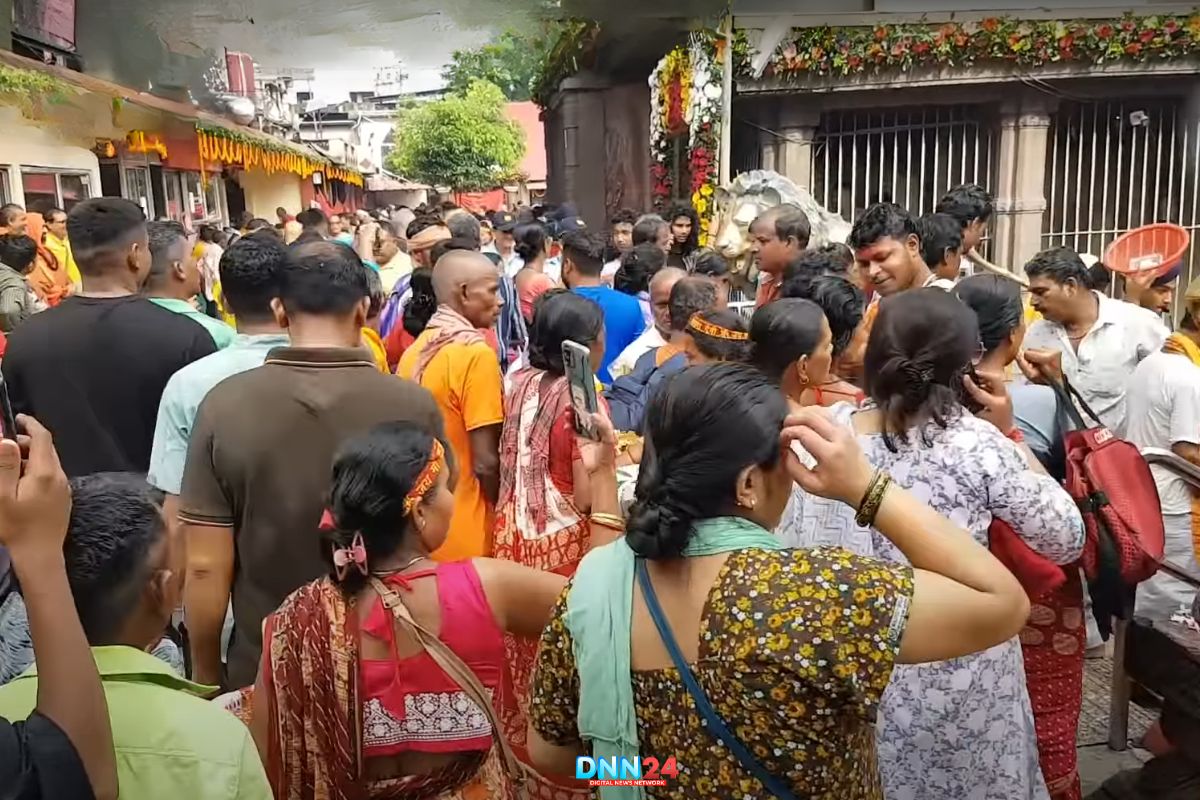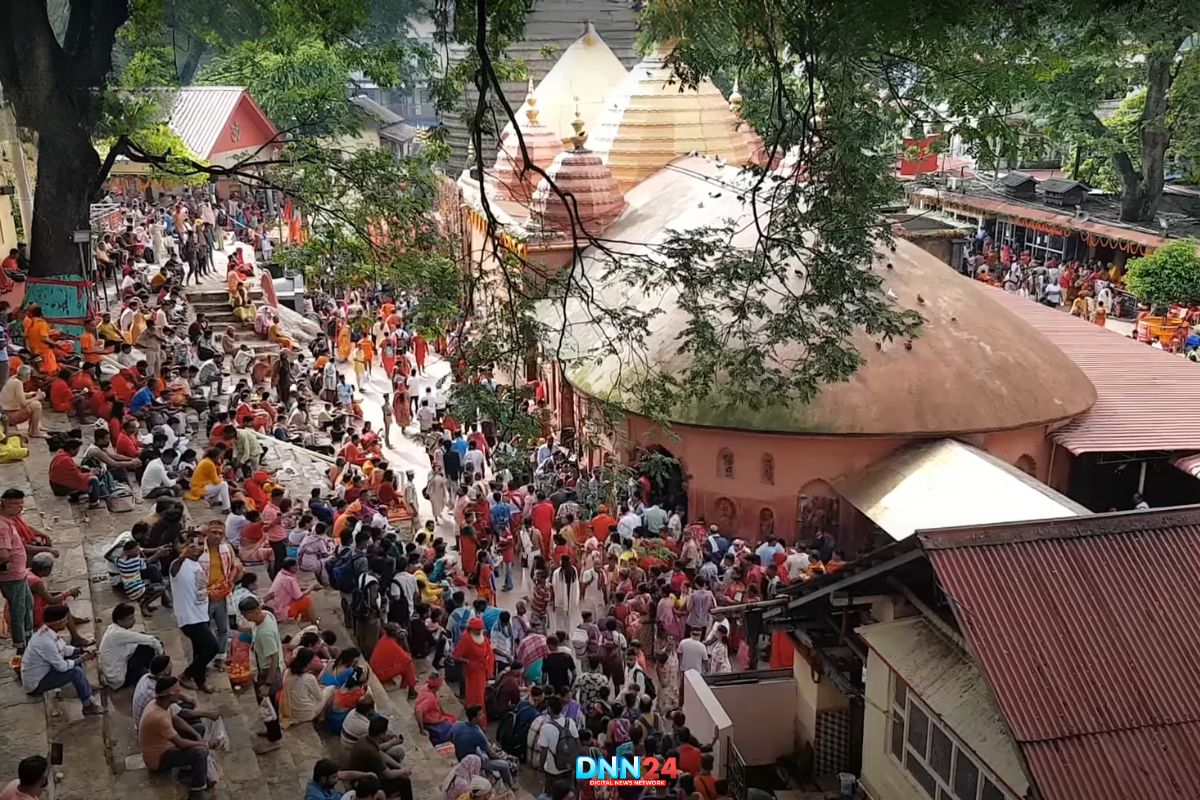Atop the mystical Nilachal Hills of Guwahati, the heart of Assam, stands the magnificent Kamakhya Temple – home to one of India’s most unique and sacred festivals. The Ambubachi Mela is not just any ordinary religious gathering; it is a powerful celebration of divine femininity, fertility, and the creative force of nature itself. This miraculous celebration celebrates the menstruation that Goddess Kamakhya does every year and makes an otherwise taboo topic in most societies to celebrate a life-giving force.
According to the devotees’ beliefs, Mother Earth enters the state of menstruation every year during June when the sun enters the constellation of Gemini and Ardra Nakshatra. This deep belief attracts thousands of pilgrims, sadhus, tantric, and atantrictual seekers all around India and the world. They do not just come to experience this miracle but to take part in what many may term as everything that was their life’s most effective spiritual journey.
The festival symbolizes the victory of feminine power over all taboos in society and glorifies the core of the creative nature within every woman. The temple doors are closed for three days, enabling its Goddess to rest. When they open at the end of this period, the whole setting turns into the celestial chorus of life, fertility, and the cycle of creation and regeneration.
The astronomy significance and sacred time The Sacred Timing and Astronomical Significance
The word “Ambubachi” itself carries deep meaning – “Ambu” means water, and “Bachi” refers to the yearly cycle. This festival is aptly synchronized with the astronomical movement, as it is celebrated as the sun moves through Gemini and is aligned with the Ardra nakshatra. According to ancient texts and learned sadhus, such celestial phenomenon generates the most potent spiritual energy on the planet, which is why the Kamakhya Temple is the center of divine feminine power at this time.

The remarkable thing about this timing, as it is believed, is that Goddess Kamakhya undergoes menstruation once a year/ per annum, unlike human women who have monthly menstrual periods. It is a phenomenon that is so sacred that it not only changes the surrounding environment of the temple but can even alter the whole scenery surrounding the temple. The Brahmaputra River, which flows majestically through Assam, is said to turn reddish during this period, symbolizing the Goddess’s menstrual flow. The ponds and water bodies around Nilachal Hills are tiny and only change color, even creating a miraculous change that angers the devotees.
Spiritual leaders and tantric think the energy produced over these three days is so power-filled that four days of meditation and worship here is equivalent to twelve years of spiritual practice in any other place. Such a phenomenal assertion attracts serious spiritual students who realize that such cosmic connection is a unique chance to make swift progress and link up with their gods.
The Wonderful Conversion of the Nature
One of the most fascinating aspects of the Ambubachi Mela is the reported transformation of the natural environment during the festival. Those devotees and sadhus who have seen this phenomenon and witnessed it several times say that the whole of Nilachal Hill appears to be transformed. The vegetation, trees, and soil seem to take on a reddish hue, as if the entire mountain is participating in the Goddess’s sacred cycle.
The most excellent affected area is the water bodies. The great Brahmaputra, usually flowing across in its typical muddy brown waters, turns reddish throughout the three days of the festival. Local devotees and visiting pilgrims gather at the riverbanks to witness this miracle, which they believe directly manifests the Goddess’s divine energy. Ponds, tanks, and streams all over that area are subject to this transformation, a land that appears to throb with feminine divine presence.
Numerous worshipers have traced this supernatural event as a historical record. It is irreconcilable to contemporary science. The transformation through whatever interpretation as a part of a divine miracle or a natural phenomenon produces an environment of awe and astonishment, which is exceptionally emotionally influential on each visitor. The reddish waters flowing through the landscape are a powerful reminder of the Goddess’s presence and the sacredness of the feminine creative force that sustains all life on Earth.
The Tantric Practices and Spiritual Significance
The Ambubachi Mela holds special significance in tantric traditions, where it is considered the most auspicious time for spiritual practices related to the divine feminine. In three days, Tantric practitioners, Aghoris, and other serious spiritual seekers around the world gather in Kamakhya because of the cosmic energies that can significantly shorten the time of spiritual progress of people during this period.

The temple’s closure during the festival is not seen as a restriction but as a necessary rest period for the Goddess. Similarly, to women who may need to rest and nurture during their menstrual periods, the divine mother is suspected to need peace and solitude during her sweet season. This idea stems from the patriarchal belief that the act of menstruation is unclean, but it is higher since there is increased spiritual power and creativity.
Throughout the festival, tantric rituals are conducted by trained ritual gurus who know the subtle energy dynamics involved. These rituals are not ceremonies but advanced spiritual technologies to tune the human mind with cosmic oscillations. The practitioners believe that by aligning themselves with the Goddess’s cycle, they can tap into the fundamental creative force of the universe, gaining insights and powers that would otherwise take lifetimes to achieve.
This is an event in nature that has been recorded by many believers for centuries, but it is still unaccountable by the scientific phenomenon of the present day. Being perceived as a Godly miracle or a natural phenomenon, transformation produces an atmosphere of awe and dedication that strongly impresses any visitor. The reddish waters flowing through the landscape are a powerful reminder of the Goddess’s presence and the sacredness of the feminine creative force that sustains all life on Earth.
The Tantric, Spiritual Significance, and Tantric Practices
The Ambubachi Mela holds special significance in tantric traditions, where it is considered the most auspicious time for spiritual practices related to the divine feminine. Skilled Tantrics, Aghoris, and other serious spiritual seekers worldwide make it a point to be at Kamakhya during these three days since they realize the cosmic forces that descend on these three days can skyrocket their spiritual path.
The temple’s closure during the festival is not seen as a restriction but as a necessary rest period for the Goddess. Women rest during menstruation periods, and thus, the divine mother requires time on her own without disturbances, too. This idea does not follow the patriarchal ideas of menstruation’s impurity, but rather, it is a period of increased spiritual power and creative energy.

The festival usually involves different tantric performances, which are conducted by qualified individuals who know the delicate energy involved in the activity. These rituals are not simple ceremonies but advanced forms of spiritual technology aimed at bringing the human mind into harmony with cosmic cycles. The practitioners believe that by aligning themselves with the Goddess’s cycle, they can tap into the fundamental creative force of the universe, gaining insights and powers that would otherwise take lifetimes to achieve.
International visitors also visit the festival because they are blown away by this kind of event honoring feminine divinity. Western scholars, researchers, and spiritual explorers usually wonder how Indian culture can turn what their societies regard as taboo into something sacred and festive, and that can teach the needed lessons in embracing natural processes and revering feminine energy.
The holy Prasad and Godly Blessings
As the doors of the temple open at the end of three days of closure, there is an electric-like anticipation and devotion. Thousands of devotees queue for hours, sometimes days, to receive the sacred prasad – a small piece of red cloth that is believed to be blessed by the Goddess’s divine energy. This red cloth, representing the Goddess’s menstrual flow, is considered one of the most powerful prasads in Hindu tradition.
This red cloth is so important to be underestimated by the minds of devotees. This cloth, treated like a sacred talisman, will be preserved painstakingly instead of eaten like other prasads. Most followers have it in their houses for Godly protection and blessings. Women especially believe that they can use this prasad to assist them with fertility complications, menstruation, and even general feminine health.
Prasad distribution is a very emotional process, and generally, the people to whom these sacraments are distributed become emotional and weep due to the divine blessing they are puffed with. The cloth is red, which, through its color, reminds the owner about the Goddess, a physical piece that can remind the Goddess of her presence. It is also common when devotees report experiencing positive energy and spiritual awareness after taking the prasad, saying that it is a life-altering moment and that they have experienced it all their lives.

The priests who serve the temple are aware of the strong psychological and spiritual effects of such a rite, as they have been observing these customs for generations. They handle every piece of prasad with absolute care because, to many believers, this minor red cloth is a sense of hope, cure, and blessing in their lives.
The Eternal Message of Divine Femininity
The Ambubachi Mela at Kamakhya Temple is a powerful testament to the celebration of divine femininity in Indian culture. To live in a society where feminine power is displaced or misperceived so often, this festival forms a dramatic contrast – the pure celebration and presence of worshiping the feminine creative power. It breaks the conventions of society, turns shame into a party, and celebrates the power of life itself.
This exceptional festival reminds us that the Goddess is not alien to the rest of nature but is a reflection of the origin of the world itself. Through the worship of Goddess Kamakhya’s menstruation, devotees honor the cosmic cycles that govern all existence. The festival teaches that what seems to be ordinary biological processes are sacred ways of manifesting divine energy and should, therefore, be respected instead of discarded.
As thousands of devotees flock to Kamakhya each year, the Ambubachi Mela remains a living tradition that bridges ancient wisdom with contemporary spiritual needs. It provides curing to women who are taught to be ashamed of what their body does; it gives spiritual experiences that truly affect serious seekers and creates a place where the divine female can be glorified in all her glorious and magnificent beauty. In celebrating the Goddess’s menstruation, we ultimately celebrate the sacred nature of life itself and the eternal dance of creation that flows through every woman and every moment of existence.
Also Read: Traditional Art Forms of Assam: A Cultural Tapestryl
You can connect with DNN24 on Facebook, Twitter, and Instagram and subscribe to our YouTube channel.

